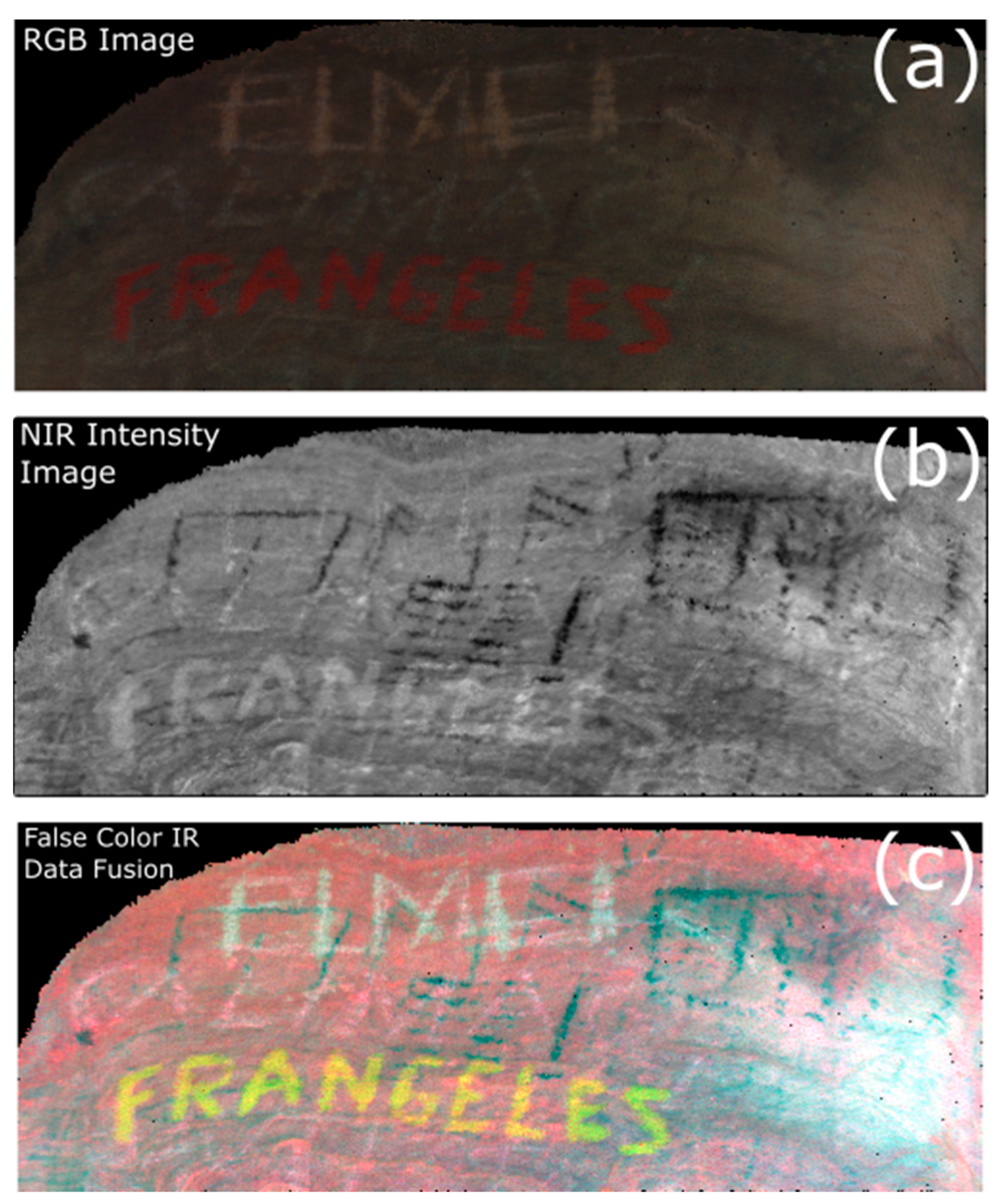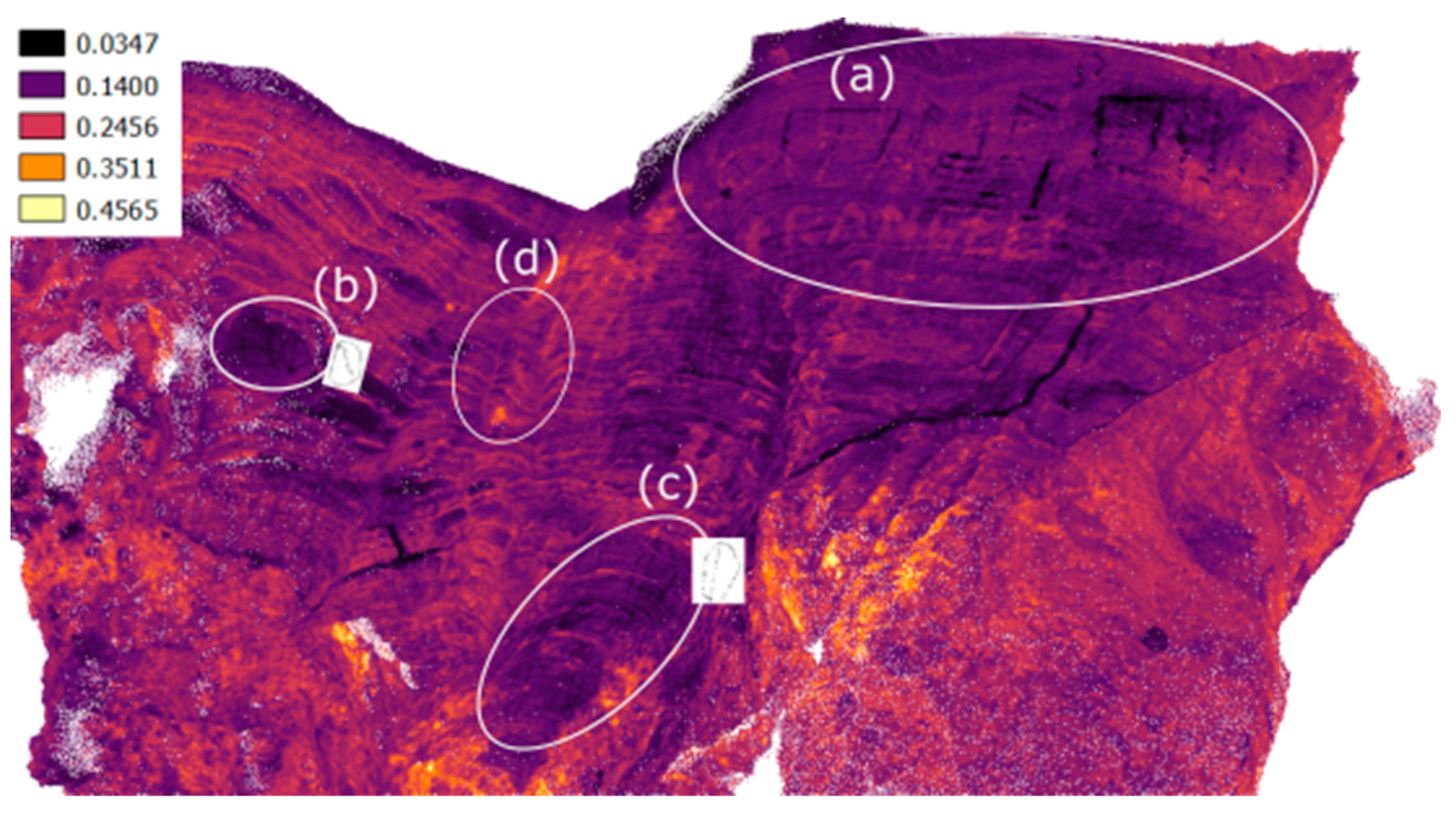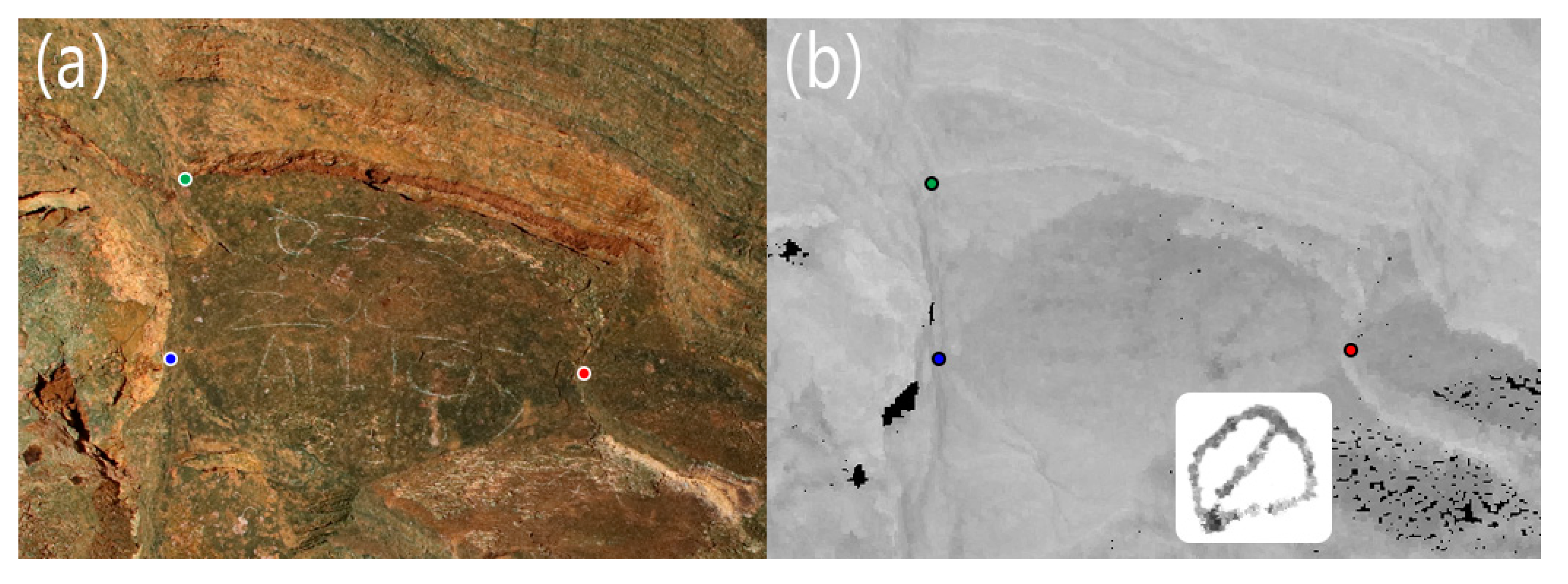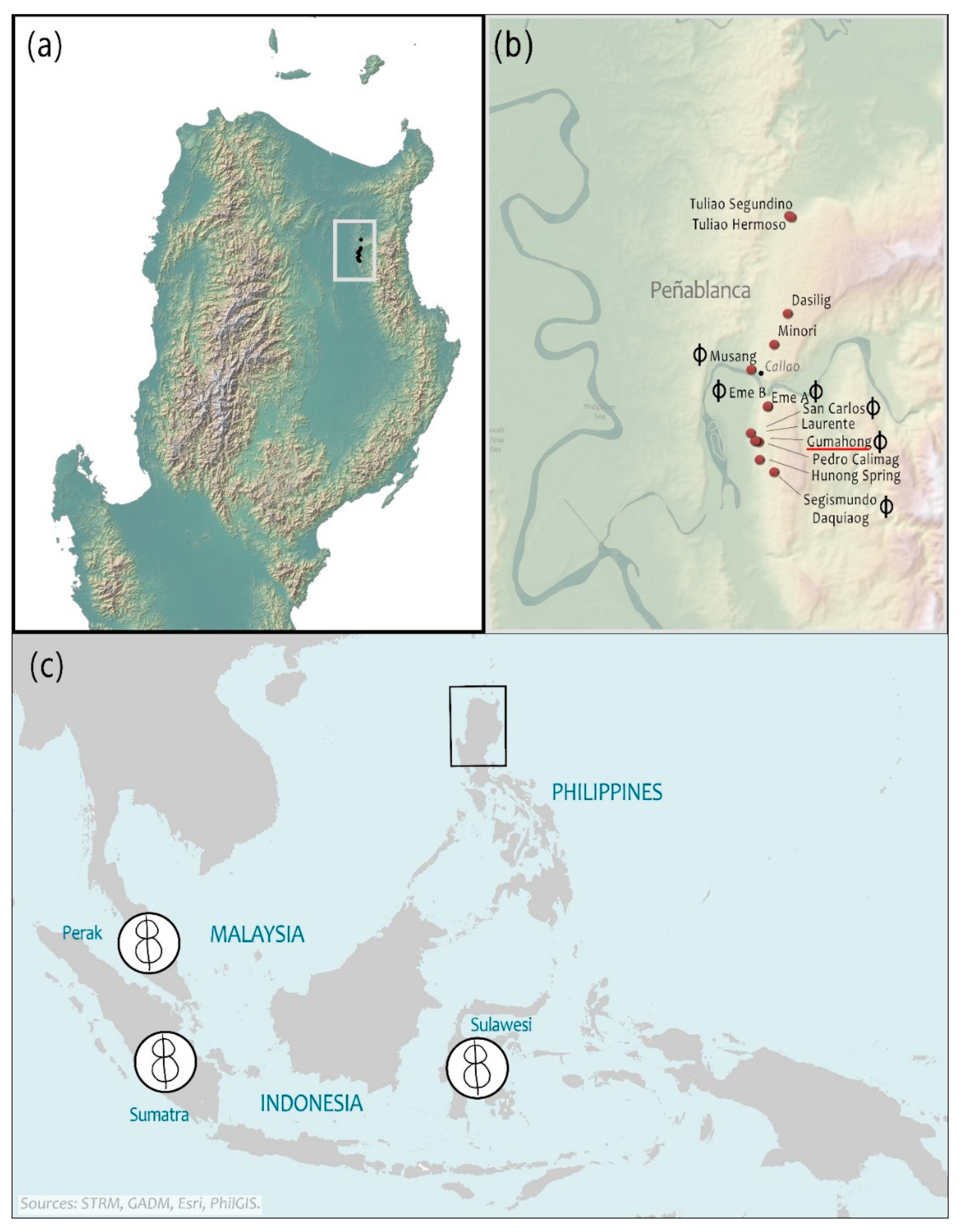Intensity Values of Terrestrial Laser Scans Reveal Hidden Black Rock Art Pigment
Abstract
1. Introduction
2. Materials and Methods
2.1. Study Area
2.2. Terrestrial Laser Scanning
2.3. Fusion of RGB + NIR Intensity Data
3. Results
4. Discussion
Author Contributions
Funding
Data Availability Statement
Acknowledgments
Conflicts of Interest
References
- Smith, B. Rock art tourism in southern Africa. Problems, possibilities, and poverty relief. In Of the Past, for the Future. Integrating Archaeology Conservation; Agnew, N., Bridgland, J., Eds.; Getty Publications: Los Angeles, CA, USA, 2006; pp. 322–330. [Google Scholar]
- Fernandes, A.B. Vandalism, Graffiti or” just” rock art? The case of a recent engraving in the Côa Valley rock art complex in Portugal. In Congresso Internacional da IFRAO 2009; IFRAO: Piauí, Brazil, 2009; pp. 729–743. [Google Scholar]
- MacLeod, I. Rock art conservation and management: The past, present and future options. Stud. Conserv. 2000, 45, 32–45. [Google Scholar] [CrossRef]
- Deacon, J. Archaeological Sites as National Monuments in South Africa: A Review of Sites Declared since 1936. S. Afr. Hist. J. 1993, 29, 118–131. [Google Scholar] [CrossRef]
- Harman, J. Using Decorrelation Stretch to Enhance Rock Art Images. In Proceedings of the American Rock Art Research Association Annual Meeting, Nevada, LV, USA, 28 May 2005. [Google Scholar]
- Jalandoni, A. An overview of remote sensing deliverables for rock art research. Quat. Int. 2021, 572, 131–138. [Google Scholar] [CrossRef]
- Balaguer-Puig, M.; Molada-Tebar, A.; Marqués-Mateu, A.; Lerma, J. Characterisation of intensity values on terrestrial laser scanning for recording enhancement. Int. Arch. Photogramm. Remote Sens. Spat. Inf. Sci. 2017, XLII-2/W5, 49–55. [Google Scholar] [CrossRef]
- Fang, W.; Huang, X.; Zhang, F.; Li, D. Intensity Correction of Terrestrial Laser Scanning Data by Estimating Laser Transmission Function. IEEE Trans. Geosci. Remote. Sens. 2015, 53, 942–951. [Google Scholar] [CrossRef]
- Armesto-González, J.; Riveiro-Rodríguez, B.; González-Aguilera, D.; Rivas-Brea, M.T. Terrestrial laser scanning intensity data applied to damage detection for historical buildings. J. Archaeol. Sci. 2010, 37, 3037–3047. [Google Scholar] [CrossRef]
- García-Talegón, J.; Calabrés, S.; Fernández-Lozano, J.; Iñigo, A.C.; Herrero-Fernández, H.; Arias-Pérez, B.; González-Aguilera, D. Assessing Pathologies on Villamayor Stone (Salamanca, Spain) by Terrestrial Laser Scanner Intensity Data. ISPRS Int. Arch. Photogramm. Remote Sens. Spat. Inf. Sci. 2015, XL-5/W4, 445–451. [Google Scholar] [CrossRef]
- Kaliszewska, A.; Bieńkowski, R.; Markiewicz, J.; Łapiński, S.; Pilarska, M.; Feliks, A. Non-invasive Investigation and Documentation in the Bieliński Palace in Otwock Wielki. In EuroMed 2018: Digital Heritage. Progress in Cultural Heritage: Documentation, Preservation, and Protection; Lecture Notes in Computer Science; Ioannides, M., Ed.; Springer: Cham, Switzerland, 2018; Volume 11196. [Google Scholar] [CrossRef]
- Skoog, B.; Helmholz, P.; Belton, D. Multispectral analysis of indigenous rock art using terrestrial laser scanning. International Archives of the Photogrammetry. Remote Sens. Spat. Inf. Sci. 2016, 41, 405–412. [Google Scholar]
- Degrigny, C.; Piqué, F. Chapter 4: Wall paintings in the Château de Germolles: An interdisciplinary project for the rediscovery of a unique fourteenth-century decoration. In Digital Techniques for Documenting and Preserving Cultural Heritage; Bentkowska-Kafel, A., Macdonald, L., Eds.; ARC, Amsterdam University Press: Amsterdam, The Netherlands, 2018; pp. 67–86. [Google Scholar] [CrossRef]
- Liang, H. Advances in multispectral and hyperspectral imaging for archaeology and art conservation. Appl. Phys. A 2012, 106, 309–323. [Google Scholar] [CrossRef]
- Grietens, B. From micro to macro: NIR sensors and imaging spectroscopy-a perfect match. Photonik Stuttg. 2008, 40, 2–4. [Google Scholar]
- Hain, M.; Bartl, J.; Jacko, V. Multispectral analysis of cultural heritage artefacts. Meas. Sci. Rev. 2003, 3, 9–12. [Google Scholar]
- Henderson, J.W. Infrared photography revisited. J. Audiov. Media Med. 1993, 16, 158–162. [Google Scholar] [CrossRef] [PubMed]
- van Rensburg, J.J.; Britton, D. Revisiting digital near infra-red (NIR) photography for subterranean rock art recording. In Proceedings of the International Federation of Rock Art Organizations XX, Valcamonica, Italy, 29 August–2 September 2018. [Google Scholar]
- Fredlund, G.; Sundstrom, L. Digital infra-red photography for recording painted rock art. Antiquity 2007, 81, 733–742. [Google Scholar] [CrossRef]
- Faylona, M.G.P.G.; Lising, C.M.Q.; Dizon, E.Z. Re-examining Pictograms in the Caves of Cagayan Valley, Philippines. Rock Art Res. 2016, 33, 1–11. [Google Scholar]
- Jalandoni, A. The Archaeological Investigation of Rock Art in the Philippines. Ph.D. Thesis, Griffith University, Griffith, Australia, 2018. [Google Scholar]
- Jalandoni, A.; Taçon, P.; Haubt, R. A Systematic Quantitative Literature Review of Southeast Asian and Micronesian Rock Art. Adv. Archaeol. Pract. 2019, 7, 423–434. [Google Scholar] [CrossRef]
- May, S.K.; Huntley, J.; Marshall, M.; Miller, E.; Hayward, J.A.; Jalandoni, A.; Goldhahn, J.; Johnston, I.G.; Lee, J.; O’Loughlin, G.; et al. New Insights into the Rock Art of Anbangbang Gallery, Kakadu National Park. J. Field Archaeol. 2020, 45, 120–134. [Google Scholar] [CrossRef]
- Domingo, I.; Villaverde, V.; López-Montalvo, E.; Lerma, J.L.; Cabrelles, M. Latest developments in rock art recording: Towards an integral documentation of Levantine rock art sites combining 2D and 3D recording techniques. J. Archaeol. Sci. 2013, 40, 1879–1889. [Google Scholar] [CrossRef]
- Grussenmeyer, P.; Landes, T.; Alby, E.; Carozza, L. High Resolution 3D Recording and Modelling of the Bronze Age Cave “les Fraux” in Périgord (France). In Proceedings of the ISPRS Commission V Symposium, Newcastle upon Tyne, UK, 22–24 June 2010; pp. 262–267. [Google Scholar]
- Leica Geosystems. Leica BLK360 Datasheet. 2017. Available online: https://leica-geosystems.com/products/laser-scanners/scanners/blk360 (accessed on 30 January 2020).
- CloudCompare. (Version 2.9 Beta) [GPL Software]. Available online: http://www.cloudcompare.org (accessed on 10 February 2020).
- QGIS. Welcome to the QGIS Project! Qgis. Available online: http://www.qgis.org (accessed on 25 September 2020).
- Kaasalainen, S.; Jaakkola, A.; Kaasalainen, M.; Krooks, A.; Kukko, A. Analysis of Incidence Angle and Distance Effects on Terrestrial Laser Scanner Intensity: Search for Correction Methods. Remote Sens. 2011, 3, 2207–2221. [Google Scholar] [CrossRef]
- Saidin, M.; Taçon, P.S. The recent rock drawings of the Lenggong Valley, Perak, Malaysia. Antiquity 2011, 85, 459–475. [Google Scholar] [CrossRef]
- Hakim, B.; O’Connor, S.; Bulbeck, D. Black drawings at the cave site of Gua Pondoa, Southeast Sulawesi: The motifs and a comparison with pigment art elsewhere in Sulawesi and the broader Western Pacific region. Archaeol. Sulawesi Curr. Res. Pleistocene Hist. Period 2018, 48, 79–92. [Google Scholar] [CrossRef]
- Oktaviana, A.; Setiawan, P. Comparative Analysis of Non-figurative Rock art at Gua Harimau Site within the Scope of The Indonesian Archipelago. In Austronesian Diaspora; Gadjah Mada Univeristy Press: Yogyakarta, Indonesia, 2016; pp. 559–570. [Google Scholar]






Publisher’s Note: MDPI stays neutral with regard to jurisdictional claims in published maps and institutional affiliations. |
© 2021 by the authors. Licensee MDPI, Basel, Switzerland. This article is an open access article distributed under the terms and conditions of the Creative Commons Attribution (CC BY) license (https://creativecommons.org/licenses/by/4.0/).
Share and Cite
Jalandoni, A.; Winans, W.R.; Willis, M.D. Intensity Values of Terrestrial Laser Scans Reveal Hidden Black Rock Art Pigment. Remote Sens. 2021, 13, 1357. https://doi.org/10.3390/rs13071357
Jalandoni A, Winans WR, Willis MD. Intensity Values of Terrestrial Laser Scans Reveal Hidden Black Rock Art Pigment. Remote Sensing. 2021; 13(7):1357. https://doi.org/10.3390/rs13071357
Chicago/Turabian StyleJalandoni, Andrea, W. Ross Winans, and Mark D. Willis. 2021. "Intensity Values of Terrestrial Laser Scans Reveal Hidden Black Rock Art Pigment" Remote Sensing 13, no. 7: 1357. https://doi.org/10.3390/rs13071357
APA StyleJalandoni, A., Winans, W. R., & Willis, M. D. (2021). Intensity Values of Terrestrial Laser Scans Reveal Hidden Black Rock Art Pigment. Remote Sensing, 13(7), 1357. https://doi.org/10.3390/rs13071357





